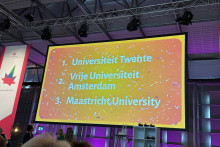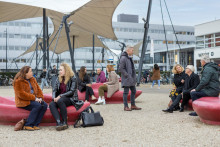 |
| A woman stuck her hand through the cracks of the three meter wall. The black scribbled words above: ‘Hilflos, Ratlos, Hoffnungslos’ meaning ‘Helpless, Desperate and Hopeless’. |
‘We arrived after traveling all night to see just a small path opened in the wall,’ she recalled the vivid memory while sitting in the university Theatre Café. ‘I got out to look at this path. It was so narrow! Just one person could fit through. And then I went back to the bus and got a hammer and started pounding on the wall. The feeling was overwhelming. I started to cry.’
The collapse of the wall was a symbolic act that moved many Europeans at that time. Many flocked to join in with sledgehammer to help with its destruction, and were called Mauerspechte (German for wall woodpeckers). When Van Barneveld, who is from Enschede and was 29 at the time, and her friends tried to return Sunday night, they faced 250 kilometers of traffic jams. They just managed to roll in at 5am, and she was at her University of Twente job on time.
|
 |
| Cars still being checked by border patrol while traveling from West Berlin to the East Berlin after the reunification of Germany. |
Feelings of freedom and hope were powerful across the world as the 140-km wall’s demise helped precipitate the political fall of the Soviet Union’s grip on Eastern Europe and allowed people once more to freely move between East and West Germany. Van Barneveld was one of the many people who flocked to join in the symbolic act, one that perhaps invoked the tumbling of their own inner walls and inspired hope.
The broken path Van Barneveld walked through in 1989 contrasted sharply with her experience two years earlier when she and her friends had driven the same bus through Checkpoint Charley for a few days holiday.
‘The East German guards came to look under the bus for contraband Genever, the Dutch liquor that they liked very much. We used to call it the ‘Party Bus’ because we would travel with a keg of beer and 15 bar stools. We didn’t have any contraband, but we teased the guard. ‘Do you want a drink?’ we asked. He did and so we gave him one, which he drank while stooping down next to the bus, acting as if he were inspecting underneath it.’
When asked what it was like to travel to East Germany then, she said, ‘Everything- all the buildings- were so grey. And the food was so different. The bread was salty and the coffee was like sewer water.’
‘The worst thing about the Berlin Wall was that people were separated from their families,’ Van Barneveld said, ‘I think when there’s a crisis or times are tough, and you have your family around, then you can manage. But when you can’t see your family…when you could be killed for trying to go and see your family,’ Van Barneveld shivered slightly.
‘I went back again in 2000. It was a totally different experience. I just did some shopping and drove through. But I did stop in the Museum Hausam at Checkpoint Charlie and it was very impressive. I remember seeing a car there that was used to smuggle people into the West. The person would be camouflaged to look like the passenger seat!’
For ten years, Van Barneveld kept a few pieces of the Berlin Wall that she collected on that momentous trip. Then one day when she was moving house, she decided to toss them. ‘They had just become pieces of colored cement,’ she said. They no longer carried her powerful experience from that historic day, one that she will always carry with her.
 |
| Graffiti painted segment of the wall, the unknown writer, wrote in two languages: ‘Die Mauer ist ein dorn in the side of Deutschland’ or ‘The wall is a thorn in the side of Germany’. |
 |
| Train tracks disappear under the wall, altering the public transport system. No trains operated between East Berlin and West Berlin for 28 years. |
 |
| The ‘rat- a- tat- tat’ of hammers striking chisels was a familiar sound in 1989, as tourists from all parts of the world came to witness the historic event. |
 |
| A so called ‘Wallpecker’ (mauerspechte) hammers his way through the thick wall erected almost overnight in August 1961. |
 |
|
A barbed wired wooden cross in memory of those killed while crossing border. Photos: Dominic Verhulst |








